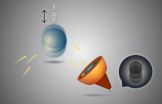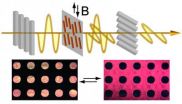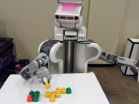Awareness month spurs web searches for autism
2014-06-26
(Press-News.org) PHILADELPHIA (June 26, 2014)—Autism Awareness Month each April brings blue lights and puzzle shapes out to shine in many communities – but does it actually lead to increased autism awareness? According to a new analysis of web search trends by researchers at Drexel University, it does appear to drive an increase in Google searches for autism – by a third over searches in March in recent years.
Brian K. Lee, PhD, an assistant professor in the Drexel University School of Public Health and research fellow of the A.J. Drexel Autism Institute, was senior author of the study with public health doctoral student Elizabeth DeVilbiss, published early online this month in the Journal of Autism and Developmental Disorders.
Using the Google trends tool (google.com/trends), they analyzed web search queries for the terms "autism" and "Asperger's" from January 2004 through April 2014 in the United States. They also compared these trends with searches for "ADHD" to assess the possible influence of broader trends in public interest in mental health issues of special interest to younger populations.
Each April, from 2004 through 2014 (except 2005), web search interest in autism spiked – up by an average of 26 percent between March and April, followed by an average decrease by 24 percent between April and May. Even sharper April spikes have occurred from 2007 through 2014, with the average March-April increase at 33 percent in those years.
A secondary, smaller increase in "autism" searches occurred each fall. Similar spring and fall oscillations occurred in searches for "ADHD" but without the sharp spike observed in April for "autism." The spring and fall oscillations may reflect a rebound in web searches in general, which tend to drop off in summer and winter, Lee said.
The overall search interest in "autism" was sustained but not increasing over the ten-year span the researchers analyzed. In contrast, "Asperger's" searches had a long-term increasing trend, with the term's popularity overall 255 percent higher in January 2014 in comparison to January 2004.
Lee and DeVelbiss pointed out a few additional spikes in the search trends that may correspond to high-impact media coverage of autism and Asperger's disorder outside of the April awareness campaigns. The Google trends tool allows users to overlay related news headlines for search terms alongside the trend chart. Lee warned that conclusions about the correlation of news headlines to search trends should be considered with caution because many could be simply accidental correlations. However, three non-April spikes were of particular note:
In September 2007, the largest monthly increase (80 percent) in searches for "autism" during the 2004-2014 span occurred. In this month, The Oprah Winfrey Show aired a high-profile segment on September 18 featuring Jenny McCarthy and Holly Robinson Peete discussing their sons with autism.
In February 2005, another peak in "autism" searches occurred, correlating with a 10-part series on autism on The Today Show, February 21-25, 2005.
In December 2012, searches for "Asperger's" increased by 122 percent over November 2012. This increase corresponded with heavy publicity regarding the planned elimination of Asperger's as a standalone diagnosis in the DSM-V.
Autism is not the only condition for which awareness months have been linked to increased search activity. A 2011 study in BMC Cancer reported that searches for breast cancer increased each October during Breast Cancer Awareness Month between 2004 and 2009, but much lower search activity occurred for prostate and lung cancers during their respective awareness months.
Search activity is also far from the entire picture of creating awareness of autism and other conditions. Whether useful and accessible information is available as a result of that search is important.
"Whether increased awareness is meaningful is another question," Lee said. "When a parent performs a web search, does it lead to recognition of autism in their child? Does it lead to seeking clinical testing and services?" Search trends can't answer those questions, but can provide a glimpse of public interest in a topic.
INFORMATION:
Link to paper: http://link.springer.com/article/10.1007/s10803-014-2160-4
ELSE PRESS RELEASES FROM THIS DATE:
New infections cause dormant viruses to reactivate
2014-06-26
GAINESVILLE, Fla. — The famous slogan is "A diamond is forever," but that phrase might be better suited to herpes: Unlike most viruses, which succumb to the immune system's attack, herpes remains in the body forever, lying in wait, sometimes reactivating years later.
Researchers have long wondered what causes herpes viruses — two strains of which are linked to cancer — to reactivate after remaining dormant once the initial infection resolves. Now a team of researchers, including two University of Florida scientists, has discovered that interactions with other infections ...
Fighting parasitic infection inadvertently unleashes dormant virus
2014-06-26
Signals from the immune system that help repel a common parasite inadvertently can cause a dormant viral infection to become active again, a new study shows.
Further research is necessary to understand the clinical significance of the finding, but researchers at Washington University School of Medicine in St. Louis said the study helps illustrate how complex interactions between infectious agents and the immune system have the potential to affect illness.
The results appear online June 26 in Science Express.
The scientists identified specific signals in mice that ...
Sequencing electric eel genome unlocks shocking secrets
2014-06-26
EAST LANSING, Mich. — For the first time, the genome of the electric eel has been sequenced. This discovery has revealed the secret of how fishes with electric organs have evolved six times in the history of life to produce electricity outside of their bodies.
The research, published in the current issue of Science, sheds light on the genetic blueprint used to evolve these complex, novel organs. It was co-led by Michigan State University, University of Wisconsin-Madison, University of Texas-Austin and the Systemix Institute.
"It's truly exciting to find that complex ...
Water-cleanup catalysts tackle biomass upgrading
2014-06-26
Rice University chemical engineer Michael Wong has spent a decade amassing evidence that palladium-gold nanoparticles are excellent catalysts for cleaning polluted water, but even he was surprised at how well the particles converted biodiesel waste into valuable chemicals.
Through dozens of studies, Wong's team focused on using the tiny metallic specks to break down carcinogenic and toxic compounds. But his latest study, which is available online and due for publication in an upcoming issue of the Royal Society of Chemistry's journal Chemical Science, examined whether ...
Not much force: Berkeley researchers detect smallest force ever measured
2014-06-26
What is believed to be the smallest force ever measured has been detected by researchers with the Lawrence Berkeley National Laboratory (Berkeley Lab) and the University of California (UC) Berkeley. Using a combination of lasers and a unique optical trapping system that provides a cloud of ultracold atoms, the researchers detected a force of approximately 42 yoctonewtons. A yoctonewton is one septillionth of a newton and there are approximately 3 x 1023 yoctonewtons in one ounce of force.
"We applied an external force to the center-of-mass motion of an ultracold atom ...
Let there be light: Chemists develop magnetically responsive liquid crystals
2014-06-26
RIVERSIDE, Calif. — Chemists at the University of California, Riverside have constructed liquid crystals with optical properties that can be instantly and reversibly controlled by an external magnetic field. The research opens the door to display applications relying on the instantaneous and contactless nature of magnetic manipulation—such as signage, posters, writing tablets, and billboards.
Commercially available liquid crystals, used in modern electronic displays, are composed of rod-like or plate-like molecules. When an electric field is applied, the molecules rotate ...
Researchers conduct comprehensive review of treatments for depression in cancer patients
2014-06-26
Depression is common in cancer, up to half of all patients facing the disease experience depressive symptoms, ranging from mild to severe. When depression co-exists with cancer, patients may be at an increased risk of death from cancer and from suicide.
Antidepressants are commonly prescribed, but the evidence on their efficacy is mixed. The role of antidepressants in treating cancer-related depression has not been rigorously studied. To identify best practice for the treatment of depression in cancer, Dartmouth researchers completed a systematic review and meta-analysis ...
Ask the crowd: Robots learn faster, better with online helpers
2014-06-26
University of Washington computer scientists have shown that crowdsourcing can be a quick and effective way to teach a robot how to complete tasks. Instead of learning from just one human, robots could one day query the larger online community, asking for instructions or input on the best way to set the table or water the garden.
The research team presented its results at the 2014 Institute of Electrical and Electronics Engineers International Conference on Robotics and Automation in Hong Kong in early June.
"We're trying to create a method for a robot to seek help ...
New species of small mammal discovered by scientists from California Academy of Sciences
2014-06-26
SAN FRANCISCO (June 26, 2014) – Scientists from the California Academy of Sciences have discovered a new species of round-eared sengi, or elephant-shrew, in the remote deserts of southwestern Africa. This is the third new species of sengi to be discovered in the wild in the past decade. It is also the smallest known member of the 19 sengis in the order Macroscelidea. The team's discovery and description of the Etendeka round-eared sengi (Macroscelides micus) is published this week in the Journal of Mammalogy.
While collecting and examining sengi specimens from southwestern ...
Miriam Hospital researchers develop app focused on making obese adults less sedentary
2014-06-26
PROVIDENCE, R.I. – Even individuals who exercise a lot can be at risk for health problems if they also spend a lot of time in sedentary behaviors, such as sitting. More sedentary time, regardless of physical activity levels, is associated with greater risk for obesity, cardiovascular disease and mortality. However, a smartphone-based intervention developed by researchers at The Miriam Hospital can produce short-term reductions in sedentary behavior that may be effective in improving health. The findings of a study that utilized this app are published in PLOS ONE, a peer-reviewed ...






